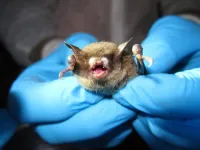(Press-News.org) MISSOULA – Since 2006, a fast-moving disease known as white-nose syndrome has killed an estimated 6.7 million bats, wiping out entire colonies and decimating creatures that provide an integral means of pest control.
In response, a first-of-its-kind study by the University of Montana recently was funded by the National Science Foundation to provide critical insights on three North American bat species that are adapting to the dual threats of this disease and climate change.
Awarded nearly $3 million dollars, the project will officially start Sept. 1, but groundwork already is well underway this summer.
Although infectious diseases occur naturally in wildlife populations, globalization and rapid environmental shifts are worsening the impact of wildlife diseases and increasing the likelihood of spillover to humans. The UM research will explore this phenomenon and is led by Erin Landguth, a public health sciences associate professor and ecological modeling researcher. She will be joined by Julie Weckworth, a UM research scientist in wildlife disease genetics, and Casey Day, a UM research scientist in computational landscape and behavior ecology.
The NSF-funded work will focus on three North American bat species significantly impacted by white-nose syndrome, a fungal disease that has devastated bat populations across the continent.
WNS is a disease that was born in Eurasia but is significantly impacting bats in North America, infecting 12 types of bats and killing millions. UM researchers are collaborating with United Kingdom scientists, including Dr. Orly Razgour, a molecular ecologist and conservation biologist who specializes in bats, and experts in bioinformatics (Dr. Rhys Farrer) and fungal pathogens (Dr. Duncan Wilson).
Collectively, the scientists will explore how certain bats have genetic traits that enable them to survive WNS and adapt to changing environmental conditions. With this data, the collaborators plan to build a sophisticated computer model that forecasts bat movement across landscapes and investigate the genetic factors that contribute to population resilience.
Using a computational model Landguth created, the research will build upon previous work by layering in climate change variables, species biological patterns and disease factors. The main objective is to more accurately understand the different aspects of tracking wildlife disease across large landscapes. The team will collaborate with U.S. Fish and Wildlife, which already has a WNS response team, and other species-specific agencies.
“Modeling disease, genetics and population movement is complex from every angle,” Landguth said. "By integrating genetic and disease processes with ecological and biological data, we can generate more accurate forecasts that can be vital for wildlife conservation and public health planning.”
The project boasts researchers with a wide range of expertise, including wildlife biology, disease ecology, microbiology, bioinformatics, computational ecology and conservation biology. Beyond scientific advancements, the project will offer practical benefits such as developing wildlife health planning maps and public education on the nuances of disease transmission in wildlife.
By identifying critical bat populations capable of resisting and tolerating disease while coping with climate shifts, this research also will aid conservation efforts. This comes at a time when the Endangered Species Act already has listed several bats species because of WNS, with other species being considered for enlistment.
“For someone who is interested in wildlife conservation, this is a disease that is super concerning,” Weckworth said. “This NSF grant will be a springboard to build more research that can help us apply tools to explicitly understand disease modeling.”
She said the study represents a significant step forward in understanding and mitigating the impacts of disease and climate change on wildlife populations, with far-reaching implications for conservation and public health.
###
END
Key takeaways
The International Astronomical Union defines a planet as a celestial body that orbits the sun, is massive enough that gravity has forced it into a spherical shape, and has cleared away other objects near its orbit around the sun.
Scientists now recognize the existence of thousands of planets, but the IAU definition applies only to those within our solar system.
The new proposed definition specifies that the body may orbit one or more stars, brown dwarfs or stellar remnants and sets mass limits that should apply to planets everywhere.
Planetary scientists are proposing ...
Toxoplasma gondii is a parasite responsible for toxoplasmosis, a lifelong chronic infection prevalent in about 30% of the human population. It poses little harm to healthy individuals but can result in severe consequences for immunocompromised people. If infection occurs during pregnancy, the parasite can cross the placenta and cause retinal or neurological issues in the developing fetus, and potentially death in severe cases.
There is currently no vaccine for Toxoplasma infection, and the biological mechanism by which the parasite affects the metabolism of host cells is still understudied.
In new research ...
Waltham — July 11, 2024 — An investigational medication designated TAS-303 shows efficacy and safety in treatment of women with stress urinary incontinence (SUI), reports a placebo-controlled clinical trial in the August issue of The Journal of Urology®, an Official Journal of the American Urological Association (AUA). The journal is published in the Lippincott portfolio by Wolters Kluwer.
"Our study adds new evidence that TAS-303 reduces the frequency of incontinence episodes in women with SUI, without the worrisome adverse ...
The fungal pathogen that causes white-nose syndrome (WNS) in bats uses different cell entry strategies depending on the host’s hibernation status – cold and inactive, or warm and active. The findings, which required the authors to develop a new bat cell line, highlight potential therapeutic interventions against WNS using epidermal growth factor receptor inhibitors, like the Food and Drug Administration-approved drug gefitinib. Bats – the second-most diverse group of mammals – play an important part in mitigating agricultural pests and the spread of insect-borne disease. However, millions of hibernating bats across North America are dying from ...
Leveraging one of the world’s oldest biological experiments – which began in 1929 – researchers have uncovered how a major crop, barley, was shaped by both agricultural pressures and its changing natural environment. The results underscore the power of long-term studies in understanding the dynamics of adaptive evolution. The survival of cultivated plants after their dispersal across different environments is a classic example of rapid adaptive evolution. For example, barley, an important neolithic crop, spread widely after domestication over 10,000 years ago to become a staple source of nutrition for humans and livestock throughout Europe, Asia, and Northern ...
New atmospheric particles form when stratospheric air intrudes into the troposphere below, according to a new study, revealing a previously unrecognized mechanism for new particle formation (NPF) in the upper troposphere. The finding suggests that NPF in these regions aloft occurs frequently and over large geographic regions, representing an important source of particles in the free troposphere. Aerosol particles smaller than one micron in diameter are abundant in the troposphere, the lowest layer of ...
Researchers from The University of Queensland have identified how a common bacterium is able to manipulate the human immune system during respiratory infections and cause persistent illness.
The research, led by Professor Ulrike Kappler from UQ’s School of Chemical and Molecular Biosciences, studied the virulence mechanisms of Haemophilus influenzae, a bacterium that plays a significant role in worsening respiratory tract infections.
“These bacteria are especially damaging to vulnerable groups, such as those with cystic fibrosis, asthma, the elderly, ...
Have you ever placed the palm of your left hand on the back of your right hand, in such a way that all fingers point in the same direction? If you have, then you probably know that your left thumb will not touch its right counterpart. Neither rotations nor translations nor their combinations can turn a left hand into a right hand and vice versa. This feature is called chirality.
Scientists at the University of Konstanz have now succeeded to imprint such a three-dimensional chirality onto the wave function of a single electron. They used laser light to shape the electron’s matter wave into left-handed or right-handed coils ...
Engineers at the University of California San Diego have trained a humanoid robot to effortlessly learn and perform a variety of expressive movements, including simple dance routines and gestures like waving, high-fiving and hugging, all while maintaining a steady gait on diverse terrains.
The enhanced expressiveness and agility of this humanoid robot pave the way for improving human-robot interactions in settings such as factory assembly lines, hospitals and homes, where robots could safely operate alongside humans or even replace them in hazardous environments like laboratories or disaster sites.
“Through expressive and more human-like ...
New research from the University of Ottawa (uOttawa) has provided a complicated glance into young women’s responses to interpersonal conflict, with retaliation often the answer to rejection and perceived social exclusion by other females.
The study, published in Nature’s Scientific Reports, highlights the complicated nature of women’s interpersonal relationships by examining the stress arising from rejection, and if the personal characteristics of those imposing the rejection influences ...




